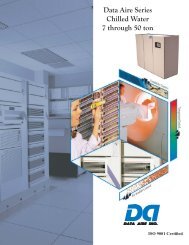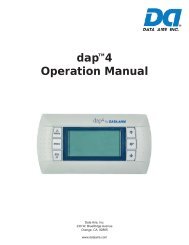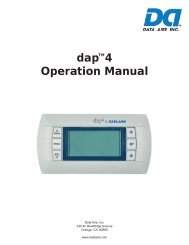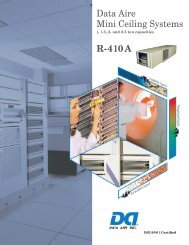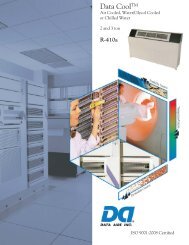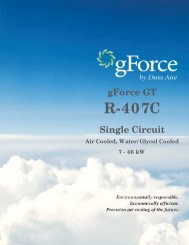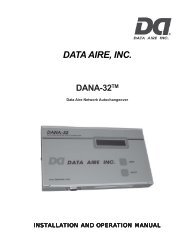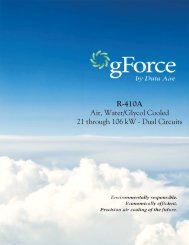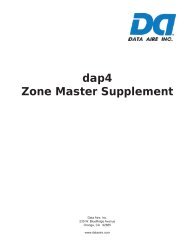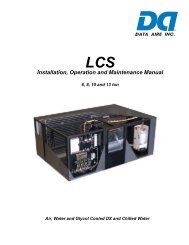Installation, Operation and Maintenance Manual - Data Aire
Installation, Operation and Maintenance Manual - Data Aire
Installation, Operation and Maintenance Manual - Data Aire
Create successful ePaper yourself
Turn your PDF publications into a flip-book with our unique Google optimized e-Paper software.
NOTE: Charging to a full liquid line sight-glass should never be the sole means of determining<br />
the correct refrigerant charge. Other parameters such as superheat, suction<br />
pressure, head pressure, sub-cooling <strong>and</strong> ambient temperature are also important. A<br />
system charged to a clear sight-glass is often overcharged.<br />
5.2.3 Fan Speed Control System Charging (Units with Remote Outdoor Condenser)<br />
The st<strong>and</strong>ard outdoor air cooled condenser provided by <strong>Data</strong> <strong>Aire</strong> has fan speed control. The fan<br />
speed controller does not require fi eld adjustment or programming.<br />
After refrigerant piping is properly completed, connect the refrigerant drum to the low side <strong>and</strong><br />
charge with vapor. For systems with R-407C, charge with approximately 2.55 lbs. per nominal<br />
ton. Systems with R-410A require 3 lbs. per nominal ton.<br />
For example, a model DAPA-0312 is a nominal 3 ton unit. Charge with about 7.65 lbs. of refrigerant<br />
if R-407C. 9 lbs. if R-410A. It is likely that more refrigerant will be required to complete the<br />
charging procedure for additional piping between the evaporator <strong>and</strong> the condenser. Make sure<br />
all hoses are properly purged. From a vacuum, feed liquid refrigerant into the high side of the<br />
system until the pressures equalizes. At this point there will be about 70-80% of the total charge<br />
in the system.<br />
For units with either the Mini DAP-III or DAP-III, a quick <strong>and</strong> easy way to run the blower <strong>and</strong> compressor<br />
is by using the manual switches provided with the microprocessor (located in the control<br />
module). Switch the blower <strong>and</strong> compressor manual switches to the ON position. All automatic<br />
control is disabled but safety switches will remain functional.<br />
WARNING: Before starting a compressor, the crankcase heater should be energized<br />
for a minimum of 12 hours to reduce the possibility of liquid slugging on start-up. Failure<br />
to energize the crankcase heater could result in compressor damage. If the system<br />
is charged from a vacuum, the pre-heating of the compressor is not necessary.<br />
Start the evaporator fan <strong>and</strong> compressor. Check the liquid line sight-glass to get a feel for the approximate<br />
charge. Bubbles in the sight-glass are not unusual at this point <strong>and</strong> can be caused by<br />
fl ashing from liquid line pressure drop, low sub-cooling or low charge. It is likely more refrigerant<br />
will be required to complete the charging procedure.<br />
Adjust the refrigerant charge until to a sub-cooling of 8 to 10° <strong>and</strong> has sparse bubbles. The unit<br />
should be allowed to stabilize for several minutes before meaningful measurements can be taken.<br />
A properly charged system operating at typical parameters will have the following pressures:<br />
Units with R-407C Head pressure<br />
Suction Pressure<br />
240 – 295 PSIG<br />
58 PSIG or greater<br />
Units with R-410A Head pressure 340 – 415 PSIG<br />
Suction pressure 104 – 121 PSIG<br />
The superheat at the compressor suction line should be 8 – 15 degrees. Sub-cooling should be<br />
8 – 10 degrees.<br />
24



